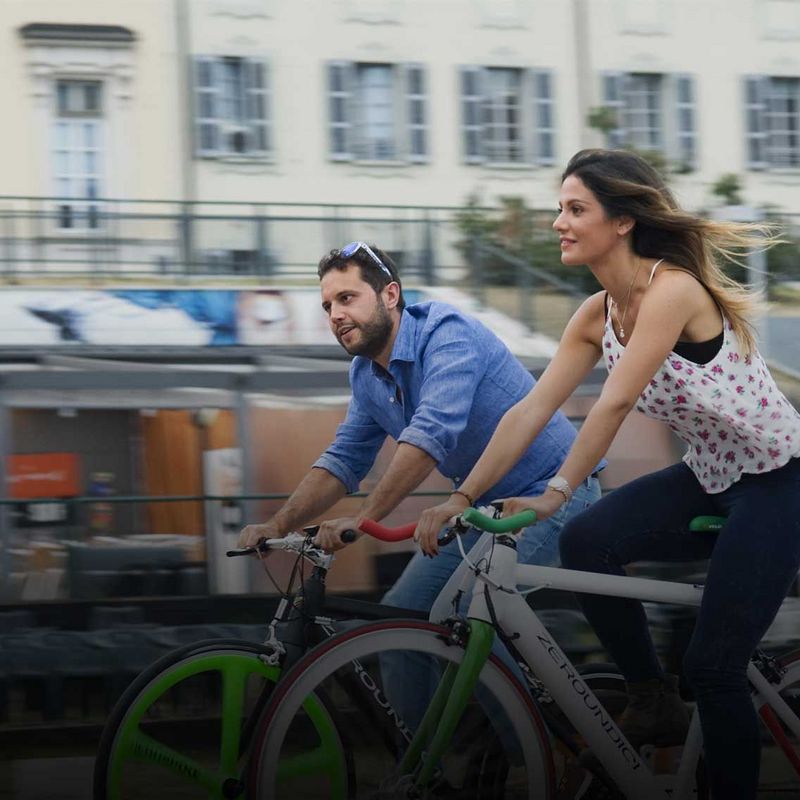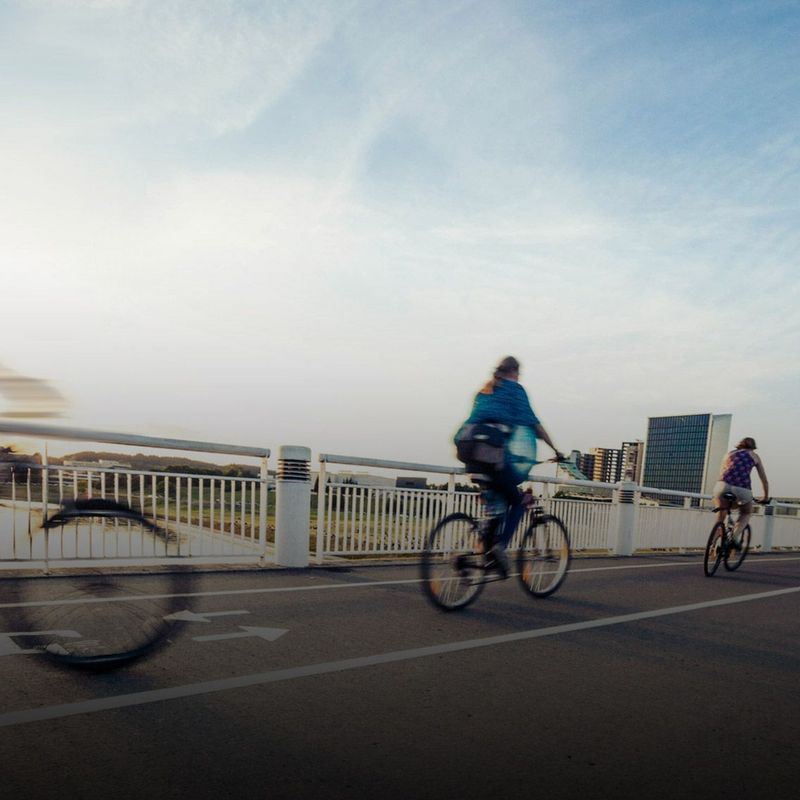25 April 2019
In France, Spain, Austria and Scandinavia, e-scooters are already whizzing through the big cities. Germany is now poised to join the ranks of those countries where these electric conveyances are permitted. To this end, the Federal Cabinet adopted the Small Electric Vehicles Directive (eKFV) in early April. The upper house of the German parliament still has to agree, but this could happen on 17 May. But while some are celebrating the electric scooter as an eco-friendly alternative for the “final mile", others are warning of accidents and chaos on bike paths and pavements. In our checklist, we clarify who is going to be allowed to use which scooters and where, and why there is so much debate about whether e-scooters should be allowed.
Where can you use e-scooters?
That depends on the speed of the scooter in question. According to the directive, scooters with top speeds of between 12 and 20 km/h may be used on cycle paths or designated bike lanes. They may be used on the road only in the absence of the above. As is the case with bicycles and mopeds, motorways are strictly out of bounds. Slower scooters that do less than 12 km/h are restricted to pavements or shared pedestrian and cycle paths. If these are not available, they may then use the roads in built-up areas.
Which technical requirements do the scooters need to fulfil?
Mandatory in all cases are two independently operating brakes and lights, although the latter can be removable. Likewise compulsory are reflectors on the sides of the vehicle and a clearly audible bell or some other similar warning signal. Motor controls such as twist grips or buttons must automatically return to their zero setting one second after release. Every standing surface must be non-slip. Prohibited under current legislation are trailers along with passengers riding shotgun, either children or other adults.
How old do you have to be to use an e-scooter?
Children from the age of 12 can use e-scooters with a top speed of 12 km/h; young people aged 14 and over can also whizz around on faster scooters. According to the legislation, neither helmets nor a driving licence are required. The reasoning is that cyclists can travel a lot faster than 20 km/h without having to sit a test. This provision has, however, been criticised by the Deutsche Verkehrswacht (DVW) and Deutscher Verkehrssicherheitsrat (DVR) road safety organisations. They are calling for a minimum age of 15 and a moped licence and recommend the use of a helmet from speeds of 6 km/h.
How are the scooters insured?
Unlike bicycles, the idea is to make e-scooters safer by insisting on liability insurance complete with an insurance sticker with an anti-forging hologram to be mounted on the back of the vehicle. But opposition is mounting here as well. For instance, Baden-Wuerttemberg’s transport minister Winfried Hermann (Greens) spoke out against the compulsory insurance as “a bureaucratic obstacle which we reject”. Another problem with compulsory insurance is that, even when they are folded up, it isn’t yet possible to take electric scooters everywhere on buses or trains. This is because the conditions of carriage of some transport companies exclude the carrying of vehicles with an insurance requirement. According to the “Welt” newspaper, you can’t take an e-scooter onto NordWestBahn or Meridian trains or the buses and trains operated by Flixbus. Which is one hurdle that could throw a spanner into the works of the electric scooter campaign. After all, the whole point is to motivate commuters to leave their cars at home and to take to electric scooters for the “last mile” between their homes, the railway station and the workplace. Whether and how the transport companies will adapt their schemes to accommodate the authorisation for road use anticipated in early summer remains to be seen.
Aren’t e-scooters bound to get in the way of pedestrians or cyclists?
This is a particularly hot topic. As far as Hessian minister of transport Tarek Al-Wazir (Greens) is concerned, the slow scooters don’t belong on pavements either – a view which, as a poll conducted by the Spiegel Online magazine reveals, is shared by the majority of Germans There is also opposition in Bremen. As the senator for transport in the state parliament, Joachim Lohse (Greens), warns: “The lack of noise made by electric scooters means that conflict with pedestrians is inevitable.” He submitted a motion to the conference of ministers to reject the opening up of pavements to “small electric vehicles”. German cycling club the ADFC said that the existing cycle paths, which are often too narrow and uneven, weren’t ready for a wave of new electric vehicles and issued a warning about accidents and chaotic conditions. Electric scooters are already causing problems in the US. The “Consumer Reports” magazine revealed that, since the end of 2017, some 1500 people had required treatment for injuries caused by accidents with electric scooters. However, it isn’t just drivers who are at fault for being careless, selfish or simply overtaxed by the technology - recurring technical defects on hire scooters are also to blame. After a number of crashes due to suddenly locking front brakes in Switzerland, the provider Lime temporarily removed all scooters from service in Zurich and Basel.
How can and should e-scooters relieve traffic congestion and help the environment?
According to the figures of scooter-sharing providers such as Bird, around 40 per cent of all car journeys today are of about three kilometres. If these journeys could be largely made using electric scooters, this would considerably reduce traffic congestion and significantly benefit the environment - this, at any rate, is what the companies promise. In combination with bus and train travel, German Transport Minister Andreas Scheuer also sees the scooters as a “real additional alternative to the car” which offer “enormous potential for the future”. This position is not, however, shared unreservedly. What is still open to question, for instance, is whether the e-scooters will actually motivate motorists to switch or whether, as transport expert Andreas Schuster from the environmental organisation Green City suspects, they will lure today's pedestrians or cyclists into a sedentary life of ease. The reasoning is that, if pedestrians and cyclists in particular switch to e-scooters, it will mean less exercise for individuals, hardly any relief of traffic congestion and more energy consumption for journeys that have previously relied on muscle power. Critics also point to the ecological footprint of the production of the small batteries and their comparatively short lifespan: They can lose their full capacity after just six months. It’s for this reason that the “Süddeutsche Zeitung” has referred to the e-scooters as the “Nespresso capsules of the road” – a glossy-looking crime against the environment that is as hip as it is practical.
How are other countries dealing with the scooters?
The scooter boom started in the US. It was there, in San Francisco, that the world's two largest sharing providers, Lime and Bird, launched in 2017. Within a very short time, they had distributed thousands of e-scooters throughout the city and spread to other US metropolises. In no time at all, scooters were lying about all over the place, electrified trip hazards on the sidewalks. It was for this reason that some cities imposed temporary bans. The total number of scooters has since been limited, and only selected providers are still allowed to operate their rental stations. Spanish big cities have also considerably tightened the rules on e-scooters after an early period of unregulated chaos. After a 90-year-old woman had been struck by a scooter and died from her injuries, e-scooters were for a while completely banned from the streets of Madrid. The scooters have since taken to the roads again in the Spanish capital but can now no longer be used on pavements, most roads or bus lanes. They are allowed only on cycle paths and, in some cases, in 30 km/h zones. The total number of rental scooters was capped at 10,000 and their top speed limited to 25 km/h.


